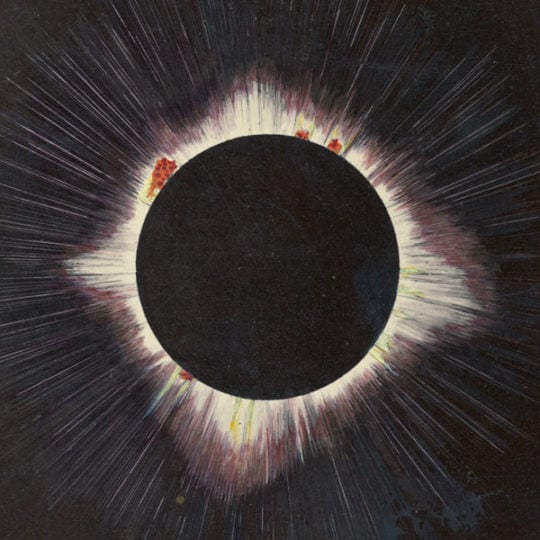Observations made by William Harkness during the 1869 total eclipse led to a pivotal discovery about the sun’s corona.
When it comes to studying solar eclipses, University of Rochester scholars have been at it a long time. Case in point: Alumnus William Harkness, whose observations of the sun’s corona during a total solar eclipse in 1869 have been hailed by some astronomers as a “landmark discovery.”
At the time, few people had ever gotten a good look at the solar corona—the outermost jacket of gases that make up the sun’s atmosphere. The sun’s blinding brilliance made studying anything in its immediate vicinity almost impossible. Only during eclipses did its radiant halo, the corona, become visible.
In fact, astronomers of the day debated whether the ring of light revealed during an eclipse was the sun’s atmosphere at all. Some thought it was just sunlight penetrating the Earth’s atmosphere. Others speculated it was a lunar atmosphere.
Here comes the sun’s corona
Harkness helped settle the debate by studying a solar eclipse on August 7, 1869, from a hilltop on the outskirts of Des Moines, Iowa, one of the cities in the eclipse’s so-called path of totality.
Vital to his research was his use of a relatively new instrument called a spectroscope, a glass prism that splits light into a rainbow of colors emitted by specific atoms and molecules. The hues act like a key to identifying different elements.
Affixing a spectroscope to a telescope enabled Harkness to observe a continuous green line ringing the sun as the moon slipped between it and the Earth and punched a hole of darkness in the daytime sky.
As documented by the United States Naval Observatory, Harkness concluded that the corona was “a highly rarefied self-luminous atmosphere surrounding the sun, and, perhaps, principally composed of the incandescent vapor of iron.”
“We have succeeded beyond our most sanguine expectations,” Harkness, who was a lieutenant commander and mathematics professor in the Navy at the time, wrote of his research in a telegraph to a colleague.
His missive was widely reported in newspapers across the country, from the Deseret News in Utah to the Burlington Free Press in Vermont.
“We have one hundred and twenty-three photographs of the eclipse, two being of totality,” he added. “. . . Could see no absorption lines in the spectrum of the corona. It gave a continuous spectrum with one bright line on it.”
His observations, which he photographed, were corroborated by those of Charles Augustus Young, an astronomy professor at Dartmouth College, who studied the same celestial event from a vantage point of roughly 160 miles east in Burlington, Iowa.
Harkness’s observations would eventually help answer the question, ‘Is the solar corona hotter than the sun?’

HARKNESS AND LIGHT: The total solar eclipse of August 7, 1869, as documented by William Harkness during his work to learn about the physical constitution of the sun’s corona, which is only visible during an eclipse. Image credit: University of Rochester Department of Rare Books, Special Collections, and Preservation
Scientists hypothesized that the green line might be the emission of a new element of the sun, which came to be known as coronium. They studied that green line during eclipses for the next seven decades before concluding that coronium was not a new element, but rather iron stripped of half of its electrons.
That finding suggested the solar corona was hotter—millions of degrees hotter—than the surface of the sun and has since helped the scientific community better understand how stars work.
Harkness, a member of the Class of 1858, was 11 years on from graduating from the University of Rochester at the time of his discovery, but he kept his alma mater in mind throughout his life. When he died in 1903, having reached the rank of rear admiral in the Navy, he bequeathed to the University his collection of nautical and scientific instruments as well as his library and papers.
Harkness Hall, which was erected on the River Campus in his honor in 1946 and originally devoted to naval science and training naval officers, today houses the Departments of Political Science and Economics.
Source: University of Rochester

